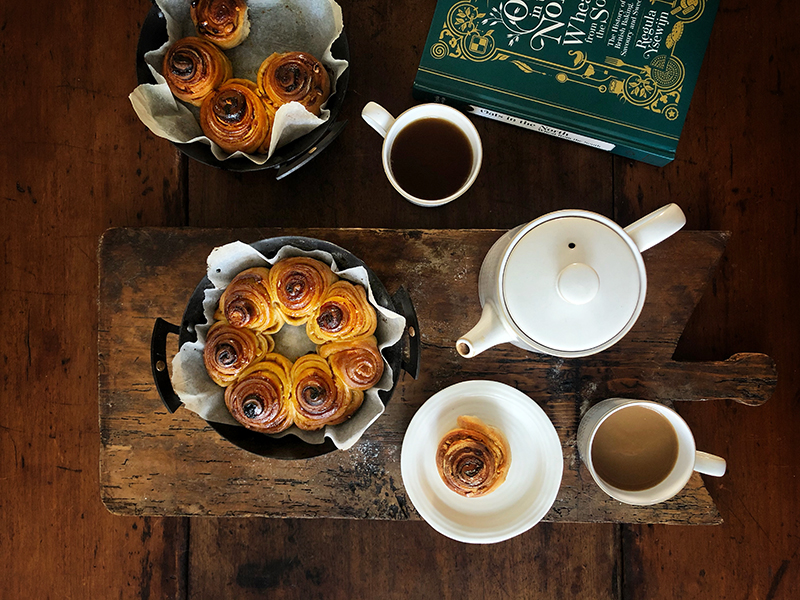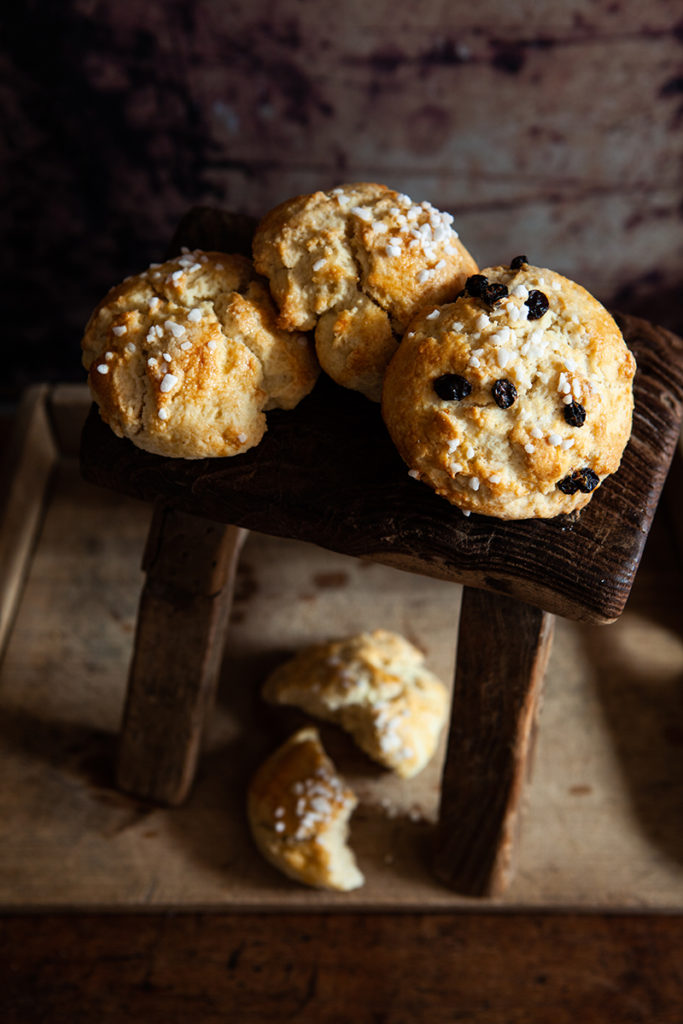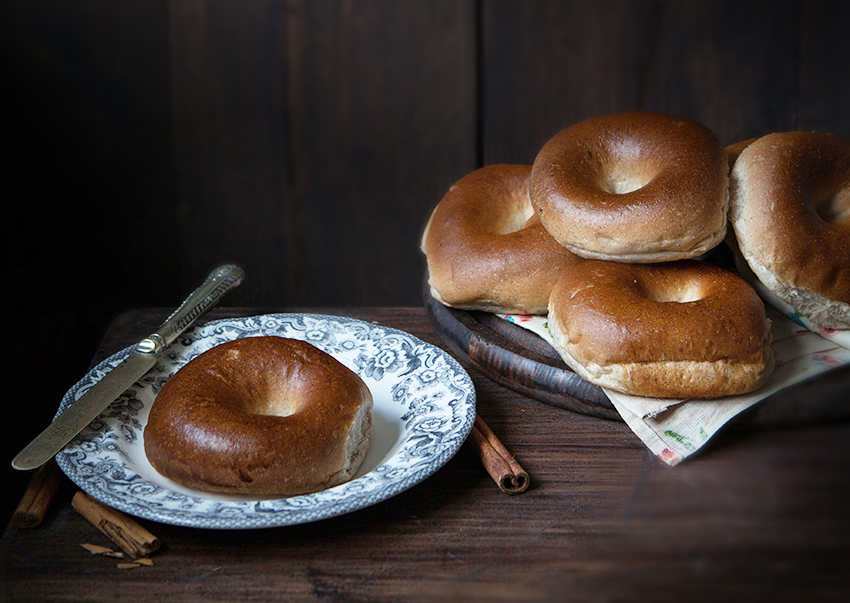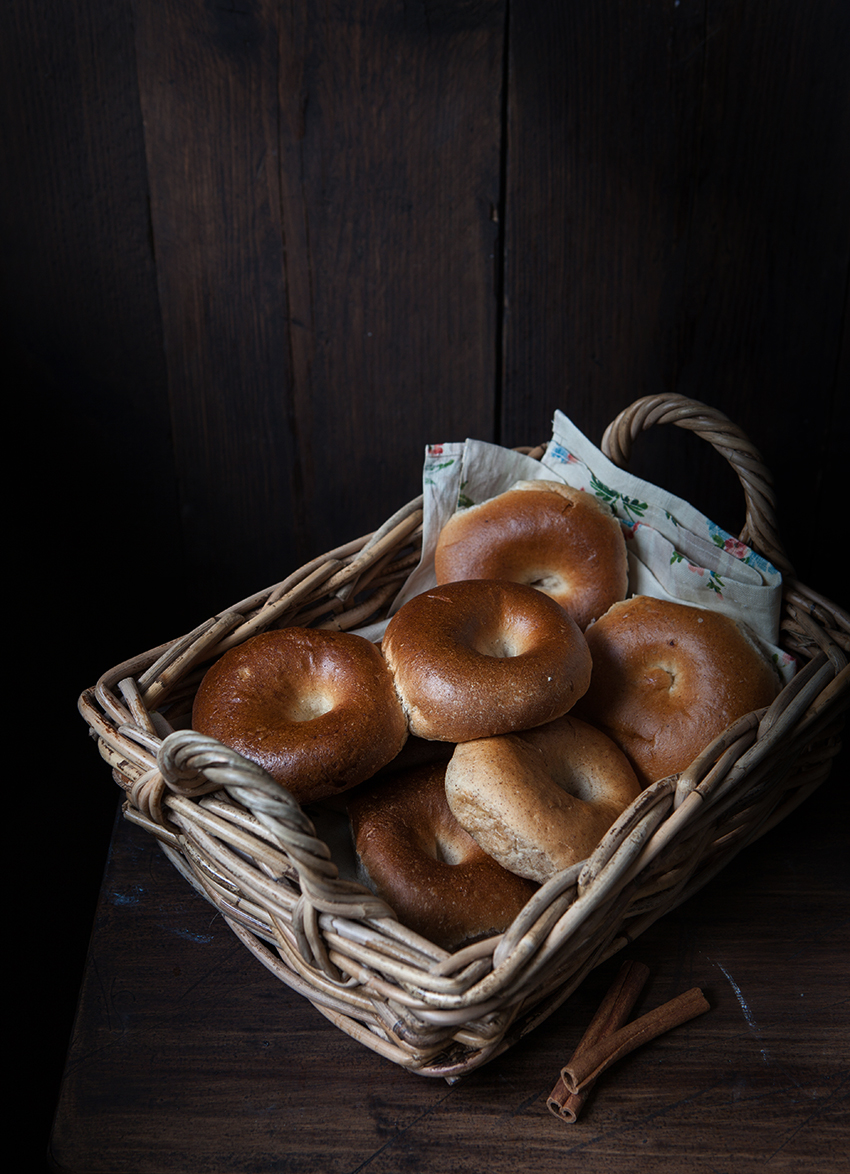The post Mini Chelsea Bun Crowns appeared first on Miss Foodwise.
]]>
I’ve been sharing videos and easy baking ideas on my Instagram @Missfoodwise during these strange times, some will be handy to make things easier for you for when you want to get some thing beautiful and delicious on the table quick. I’ve posted a few recipes from my new book Oats in the North Wheat from the South – which came out in full lockdown and saw all my events in the UK cancelled. Luckily I was able to do my BBC Womans’ hour interview over the phone as I would have been sad to miss is.
I also posted some ideas for overnight doughs so you can prep before bed and bake in the morning for breakfast or lunch. This is one of those bakes (there is also overnight bread buns and quick pan pizza for same day baking) that looks great on your table, looks great to give as gifts – I’ve gifted one of the crowns to my neighbours who are doctors and can use some unexpected cheer and sweetness right now.
These buns are a variation on my Chelsea buns from the book but made so that you can leave the dough at room temperature overnight. If you want to bake them to eat on the same day, add more yeast as explained below.
Makes 3 small crowns
- 6 g dried yeast (15 g if you are baking on the same day, then first rise is 1 hour)
- 300 ml full-fat milk, room temp (lukewarm if you’re baking on the same day)
- 500 g strong white bread flour
- 60 g raw (demerara) sugar or white sugar
- 1 tsp ground cinnamon (or use pumpkin spice instead of the spices)
- 1/4 tsp ground mace
- ¹⁄8 tsp ground coriander
- 70 g butter, at room temperature, cubed
- 1 egg
- 5 g fine sea salt
For the filling
- 3-4 tbsp lemon curd
- 2 tbsp fine sugar
- Chopped hazelnuts
- Milk for brushing
For the sugar syrup
- 60 g (2. oz) raw (demerara) sugar or
- white sugar
- 5 tbsp water
- caster (superfine) sugar, for sprinkling
Method
Combine the flour, yeast, sugar and spices in a large bowl or the bowl of an electric mixer fitted with a dough hook and put the butter on top. Pour half of the milk over the butter and start kneading. When the milk and butter are completely absorbed, add the rest of the milk , along with the egg. Knead for 5 minutes, then let the dough stand for a few minutes (at this point it will be very wet). Add the salt and then knead for 10 minutes, scraping the dough off the dough hook and side of the bowl if needed, until the dough has come together in a smooth and elastic dough that is not too dry but also not terribly wet.
Cover the dough and set aside for 1 hour until it has doubled in quantity – OR WHEN USING THE OVERNIGHT METHOD: cover the bowl with the dough with plastic and leave until te morning at room temperature.
Line the baking tin or pan(s) with baking paper. Towards the end of the resting time, or in the morning, preheat the oven to 210°C
Divide the dough in two and shape one piece to a rectangle, roll out as thinly as possible, making sure you keep the shape (I’ve posted a video on my instagram feed @Missfoodwise)
Spread the dough with half the lemon curd, sprinkle over half the sugar and cover in half the chopped nuts. Divide lengthwise in 3 cm strips and roll those over to fill your tin(s) or pan(s) with. Do the same with the other half of the dough and then brush the buns all over with milk. These buns do not need to rise as we want the layers thin, so you can now immediately bake them! However if you like you can of course let them rest for an hour, or more, and your layers won’t be as thin.
Bake for about 20 minutes until golden brown, meanwhile prep the sugar syrup by heating the sugar and water in a small saucepan until the sugar has dissolved. Brush the buns with the sugar syrup as soon as they come out of the oven and then decorate with either coarse sugar, tiny sugar nibs, more nuts or leave plain and shiny!
The next day the buns are easily reheated in a hot oven for 5 minutes, they’ll taste freshly baked!
Enjoy!
Follow me on Instagram to stay up to date with videos etc, my new book is for sale over here >
The post Mini Chelsea Bun Crowns appeared first on Miss Foodwise.
]]>The post Brighton Rock Cakes – from Oats in the North, my new book appeared first on Miss Foodwise.
]]> Recipe and extract from Oats in the North, Wheat from the South, published with Murdoch Books and available here >
Recipe and extract from Oats in the North, Wheat from the South, published with Murdoch Books and available here >
Usually these buns appear as ‘Rock cakes’ or ‘Rock buns’ in old cookery books, but in 1854 two recipes for Brighton rock cakes appeared in George Read’s The Complete Biscuit and Gingerbread Baker’s Assistant. Read gives a recipe for Brighton rock cakes and another for Brighton pavillions. The latter are made the same way as Brighton rock cakes, but are finished with a topping of currants and coarse sugar that, he says, should be ‘as large as a pea’.
You can still buy Brighton rock cakes in the seaside town of Brighton at the Pavilion Gardens Café. The open-air kiosk at Brighton Pavilion has been selling Brighton rock cakes since 1940, and possibly even longer if we look at Read’s recipe from 1854. Rock cakes are popular throughout Great Britain and Northern Ireland, and often appear in literature. In Harry Potter and the Philosopher’s Stone, Hagrid serves them to Harry and Ron, and Agatha Christie also mentions them in more than one novel.
I wanted to share this recipe in publication week of my new book Oats in the North, Wheat from the South because currently I am missing the sunny Brighton beach, the buzzing pier, and the busy Brighton lanes with its independent shop walhalla. I miss the days without worry when we drove over to the UK for a weekend, antiquing, walking, eating… When the Corona crisis is over I’m planning a trip, but I wonder how we will feel post Corona, will we be free of worry or will the way we live change?
But for now, we can bake, do join my #bakecorona on social media.
This recipe only uses one egg, in a time when eggs are dear this recipe might be a solution, other recipes from the book which can be handy during shortages are the Soda bread – to save yeast, the Parkin – to save sugar, the Cornish Heavy cake NO eggs at all, Yorkshire parkin – just oat flour needed, the fat rascalls – just 1 egg needed, Swiss roll – no baking powder but lots of eggs, Flapjack – uses just oats or leftover muesli. And to save an egg, I use an egg less in my pound cake! Happy baking…
This recipe for Brighton rock cakes contains candied cedro, but most rock cakes only contain currants, so you can easily leave it out.
Recipe from Oats in the North, Wheat from the South, published with Murdoch Books and available here >
For 6 rock cakes
- 225 g plain (all-purpose) flour
- 100 g raw cane (demerara) sugar or white sugar
- 1 tsp baking powder
- 1/4 tbsp mixed spice
- pinch of sea salt
- 75 g chilled butter, diced
- 1 egg
- 3 tbsp full-fat milk
- 50 g currants
- 30 g candied cedro (optional)
- 3 glacé cherries, halved, to garnish (optional)
- nibbed sugar, to garnish (optional)
Method
Preheat your oven to 200°C (400°F) and line a baking tray with baking paper.
Mix the flour, sugar, baking powder, mixed spice and salt in a large bowl. Add the butter and rub it into the flour mixture until it has the consistency of breadcrumbs.
Stir in the egg, then add enough milk to bring the dough together without making it too wet. If the dough is too dry to press together, add a teaspoon of milk. Fold the currants and candied cedro through the dough. Form six rock cakes using two forks – this will help achieve a rugged, rocky look. Place on the baking tray and decorate with the cherries and sugar, if using. Bake in the middle of the oven for 15 minutes until the rock cakes have a golden blush.
The post Brighton Rock Cakes – from Oats in the North, my new book appeared first on Miss Foodwise.
]]>The post Buns for Saint Hubert: Mastellen from Ghent appeared first on Miss Foodwise.
]]> The city of Ghent ’s most famous bake is called ‘Mastel’ and it is a soft bun flavoured with cinnamon shaped into a round with a dimple in the middle made by pressing down four fingers in the dough. The name Mastel comes from ‘masteluin’ a bread mixture made with wheat and rye flour, it was an old practice to grow the two grains mixed on one single field to improve yield. Since medieval times the bun was consecrated by a priest and eaten as a preventative against hydrophobia or rabies on the feast of St Hubert on 3 november. Today the bun is often blessed on the 3rd of november but no one really believes it will protect them from hydrophobia or rage.
The city of Ghent ’s most famous bake is called ‘Mastel’ and it is a soft bun flavoured with cinnamon shaped into a round with a dimple in the middle made by pressing down four fingers in the dough. The name Mastel comes from ‘masteluin’ a bread mixture made with wheat and rye flour, it was an old practice to grow the two grains mixed on one single field to improve yield. Since medieval times the bun was consecrated by a priest and eaten as a preventative against hydrophobia or rabies on the feast of St Hubert on 3 november. Today the bun is often blessed on the 3rd of november but no one really believes it will protect them from hydrophobia or rage.
Mastellen are also sold dried to use for making a pudding called ‘Aalsterse Vlaai’ and the dried out bun was also often soaked in buttermilk to eat as a gruel. A custom that is in decline is that of the ‘ironed mastel’ where a mastel bun is sliced in two and spread with butter and a generous topping of brown sugar. The bun is then crushed under the weight and heat of an old fashioned heavy cast iron well eh – iron. The kind that used to be kept on the stove. The result is a crisp biscuit that resembles a Lackman waffle. Truly delicious. This ironing of the mastel is popular on the first weekend of august in the Ghent area called Patershol during the Patershol feasts, a jolly folk festival in one of Ghent’s most culturally diverse area, it is therefore also called Coté Culture. (Patersholfeesten are his weekend if you’re in the area! Also check previous post on where to go and eat in Ghent – I will be adding to this post over time.)
The custom of eating consecrated bread on St Huberts day comes from the story that the saint cured a man of rabies by giving him bread to eat. St Hubert was the Bishop of Liege and the patron saint of hunters, on the 3rd of november an event takes place in Liege where the hunting hounds, masters and staff are blessed by a priest. This date also marks the start of the hunting season.
There are other places where the custom of eating a special spiced bun or bread on St Hubert is still alive, the area round Essen in Belgium where they carry a carved in cross and are called ‘Huubkes’ after St Hubert and other areas of East Flanders of which Ghent is the capital. In the the Dutch town of Breda in Brabant, the buns are called Hupkes and the tradition is identical. God fearing farmers even ordered the consecrated buns to feed to their livestock to protect them from disease. Some bakers have to go to church with their baskets of mastellen, Huubkes, or Hupkes, other priests come to the bakery to give their blessing there.
Originally the St Hubert buns were flavoured with aniseed and in some areas they still are, others are made with raisins, but for as long as anyone can remember their seasoning in Ghent has been cinnamon, and I’m sad to say that even the cinnamon version is getting rarer as my local market in the town I just left, only sold a few with cinnamon, most of the mastellen were plain buns.
It is very possible the custom of eating a blessed bread, either with a dimple made with four fingers or a cross comes from pagan times as st Hubert is known for evangelising pagans in the Ardennes forests in Belgium (then France). The best way to assimilate is to take over customs, something christianity is famous for as many christian traditions are adaptations of pagan rites.
The recipe for these mastel buns are those that are sold today, the buns sold in the 8th century would have been much more heavy and not to modern taste. As with everything, the recipe evolved over time to what it is today.
Special thanks to Ilse Buyens, a former baker in the Essen area and a friend for nearly 20 years!
Recipe
What do you need, For 15 mastellen
- 500g bread flour
- 50g raw cane sugar (or plain)
- 2,5 g cinnamon (or anisseed, crushed)
- 230ml full fat milk
- 15 g dried yeast
- 70g butter, room temperature
- 2 medium free range eggs
- 10g seasalt
- 1 egg + 1 tsp of milk for egg washing
Method
Place your flour and sugar in the bowl of a mixer and add the cinnamon or other seasoning, warm the milk a little and add the yeast so that it can foam up.
Pour half your milk and yeast mixture in the mixer along with one beaten egg and the butter. Knead on medium and when combined add the rest of the milk and the second egg and finally the salt. Knead on slow for 15 minutes then let the dough rise for 30 minutes, covered.
Make balls of dough of about 50 grams per ball, let them rest for 10 minutes.
Now shape the balls to whatever shape you like, just plain round for a traditional shape, placed close to each other so they are stuck together after baking and place them on your baking tray, now press four fingers down in the middle to create the dimple. Cover with a cloth and let the buns rise for 40 minutes.
When you are ready to bake egg wash the top of the buns to give them a shine.
Preheat your oven to 225°c and bake for about 10 minutes or until golden brown.
Recipe for “ironed” Mastellen
Slice a bun in half, spread generously with butter, top with brown sugar, place between two sheets of baking paper and use a hot iron or a heated heave based pan to crush the bun. Some people use a toastie machine.
You might also like
This travel post for Ghent >
The post Buns for Saint Hubert: Mastellen from Ghent appeared first on Miss Foodwise.
]]>
